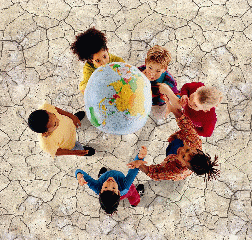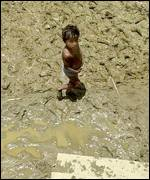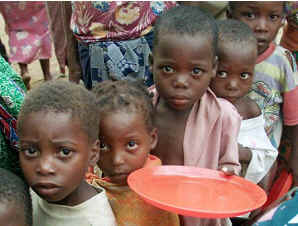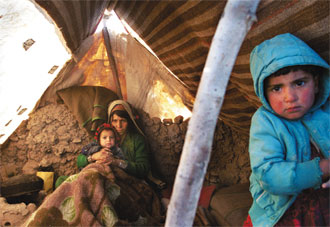The impact of climate change on children
Save the Children UK’s
Humanitarian Policy Team April 2007![]()

Quick facts: climate change and children
- In the next decade, up to 175 million children are likely to be affected every year by the kinds of natural disasters brought about by climate change.1
- The percentage of the world’s population exposed to malaria, one of the biggest killers of children under the age of five, is expected to increase from 45 per cent to 60 per cent in the next 100 years due to climate change.2
- By 2010, there will be 50 million 'environmentally displaced people', most of whom will be women and children.3
Climate change will compound existing threats to children’s health,
food security, livelihoods, protection and education.
Children make up approximately 50 per cent of those affected by disasters.
(Evidence from UNHCR and Save the Children’s field experience indicates that at least half of all those
affected in emergencies are children.)
Climate change will have an acute impact on riverine, coastal and island communities, as well as low-lying
regions, mountain areas dependent on glaciers for water, and much of sub-Saharan Africa. Children in these
communities are likely to face threats to their health, safety and their families’ livelihoods.
climate change threatens sustainable development, potentially deepening children’s
poverty and increasing their vulnerability to abuse, exploitation and displacement.
1This is a considered estimated based on data from the International Federation of the Red Cross and Red
Crescent Societies World Disasters Report 2006
2 Watterston, Tony and Simon Lenton. Sustainable development, human induced global climate change,
and the health of children. British Medical Journal 87 (1997): 95-97.
3The UN University’s Institute for Environment and Human Security, 7 March 2007 http://www.ehs.unu.edu/index.
C limate
change will also contribute to typically overlooked
limate
change will also contribute to typically overlooked
'slow-moving' disasters, including desertification, rising sea levels
and degradation of forests and fisheries.
In the most severe cases of land degradation, of which desertification is a part,
affected land becomes unusable and damage is irreversible.
This has a dramatic impact on children’s lives, their access to food
and water, and economic stability.
Sub-Saharan Africa already has the world's highest rate of urban migration.
(The challenges facing an urban world, BBC, 7 March 2007 http://news.bbc.co.uk/1/hi/sci/tech/5054052.stm.)
More than a billion people already live in urban slums where child mortality is 10-20 times greater than
in cities with adequate sanitation. (Waking up to realities of water and sanitation problems of urban poor,
press release HAB 184,UN Habitat. 7 March 2007 http://www.un.org/News/Press/docs/2003/hab184.doc.htm. ) A13_s7_1
The impact of climate change on children (cont.)
Children’s direct or indirect dependence on subsistence farming and agriculture, which is highly
vulnerable to climate variability, places them at particular risk to the consequences of climate change.
Fuel and food availability for families and their livestock are subject to several factors, including
weather, changes in technology, changes in trade patterns and change in patterns of demand for cereals.
Threats to children’s health
more children under the age of five in developing countries already die of malnutrition
than of anything else. (The Stern Review)
W orse,
malnourished children, already particularly vulnerable
orse,
malnourished children, already particularly vulnerable
to infection, are likely to be exposed in greater numbers to
vector-borne diseases such as malaria and dengue fever as a
result of increased flooding, warming and changes in rainfall.
Climate change will also threaten safe drinking water and
sanitation.
Rising sea levels could lead to the salinity of estuaries,
which might threaten groundwater sources.
If safe drinking water in contaminated, people will rely
more and more on unsafe sources.
There is also the possibility that in some areas rising sea
levels will flood latrine pits, polluting groundwater.
This could have a particularly deleterious effect on children’s health, as diarrhea already accounts for
nearly two million deaths of children under the age of five.
Several other climate-sensitive diseases, including Rift Valley fever, Chagas’ disease, cholera,
leishmaniasis, yellow fever and tick-borne encephalitis, are likely to increase as the effects of climate
change, particularly flooding, create ideal environments for diseases to spread and mosquitoes to breed.
(Impacts, vulnerability, and adaptation to climate change in Africa for the African Workshop on Adaptation, Implementation of
Decision, UN Framework Convention on Climate Change, UNFCCC Convention (Ghana), September 06)
children are key to addressing both disaster risk reduction and climate change issues
c hildren
as leaders and activists can bring about
hildren
as leaders and activists can bring about
major changes in knowledge, attitudes and practices.
As they are disproportionately affected by disasters,
Relief and aid programmes must have an adequate
assessment of children's needs and rights, and involve
them in the design of the strategies.
This not only decreases the specific risks children face,
but it ensures their participation and, as a result,
increases their capacity and confidence to cope with
disaster.
A13_s7_2